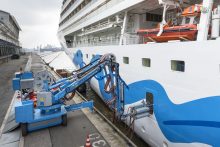Over the past decade, tourism has embraced sustainability as a strategic pillar. A WTTC report shows that 42% of leading tourism companies globally have set a climate target – either interim, long-term, or both. As sustainable business practices gain traction around the world, companies must increasingly consider the concerns of stakeholders – travellers seeking eco-friendly destinations, and communities concerned about their future.
 Tour operators
Tour operators
Emissions from tour operators vary across the sector, depending on how asset-light or asset-heavy they are. Some operators express concerns about limitations they encountered regarding infrastructure at destinations, while others are investing in sustainability initiatives. But the current infrastructure and technology at some destinations are not developed enough for those investments to yield results in the short term. For example, some tour operators want to invest in electric buses, but current EV coach battery life is inadequate for longer tours.
 Travel agencies and OTAs
Travel agencies and OTAs
Travel agents — both brick-and-mortar and online — interact with a variety of industry players, from suppliers to destinations, and influence consumer choices. They are well-placed to help the industry achieve its sustainability goals, though these efforts are complicated by the new reporting frameworks. OTAs and travel tech companies more broadly are not easily classified, as they often fall in the software sector rather than tourism. As such, they also lack specific guidance on how to tackle sustainability issues relating to their travel operations. They will likely have to consult sector-based guides, such as for car rental and leasing, hotel and lodging, and airlines.
 Accommodation
Accommodation
One complicating factor for hotel chains is the industry’s range of business models and ownership structures. Many operate under franchise agreements with multiple levels of control, from brand owners to property managers and owners. Implementing a data collection system across the franchise and performing data assurance when dealing with multiple different stakeholders and a more complex governance process can be arduous. This is also true when sharing guidelines and sustainability principles with general managers and other value chain partners handling the operations, who must go through proper training and ensure their property complies with sustainability policies of the group. In addition, accommodation providers often rely on local infrastructure and third-party services, such as waste management services and facilities, laundries, and on-site renewable energy sources. This requires additional coordination.
 Aviation
Aviation
Air travel accounts for over 2% of global carbon emissions. Since the industry is so global and the bulk of aviation’s emissions are Scope 1 — the easiest emissions to quantify and control because they involve a company’s direct operations — airlines are under more pressure to disclose their carbon footprints. As a result, there are multiple ongoing initiatives pushing the sector to decarbonise, such as ICAO’s Carbon Offsetting and Reductions Scheme for International Aviation. The primary short-term solution relies on switch to sustainable aviation fuel (SAF), with less carbon-intensive technologies such as hydrogen-powered or electric aircraft not yet commercially viable. While more expensive than conventional jet fuel, SAF eliminates between 50% to 80% of lifecycle emissions.

Cruises
The International Maritime Organisation aims to regulate the impact of cruise ships on the environment by adopting a framework to reduce the carbon intensity of international shipping by 40% by 2030. There are several ongoing initiatives to shrink the subsector’s carbon footprint, including one led by CLIA. CLIA has committed to net-zero carbon emissions by 2050 and focuses its efforts on alternative greener energy sources, as well as partnerships with cities and ports for sustainable destination management. Like the airline industry, cruise lines also struggle with the lack of market-ready and scalable low-carbon energy sources to power ships, such as renewable diesel, liquefied natural gas, green hydrogen, or electric batteries. The sector will also have to face competing demand from other sectors, such as road transportation and aviation, to source these more sustainable fuels.
 Tourism Breaking News
Tourism Breaking News


